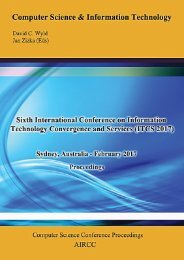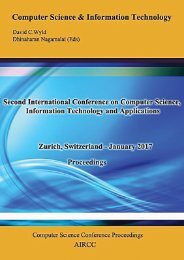CoSIT 2017
Fourth International Conference on Computer Science and Information Technology ( CoSIT 2017 ), Geneva, Switzerland - March 2017
Fourth International Conference on Computer Science and Information Technology ( CoSIT 2017 ), Geneva, Switzerland - March 2017
Create successful ePaper yourself
Turn your PDF publications into a flip-book with our unique Google optimized e-Paper software.
128 Computer Science & Information Technology (CS & IT)<br />
provide experimental evidence of the significance of including non-standard fields as input<br />
features for the learning algorithm.<br />
Our approach supposes that we can learn from historical data on defects that have similar<br />
characteristics to a new defect and use this to make predictions on the defect handling time that<br />
are more accurate than many comparative approaches. We found that in real life, the available<br />
data was often of poor quality or incomplete, and so in implementing our solution we encountered<br />
a number of challenges, which we discuss in this paper.<br />
Figure 1: Training process<br />
Our approach is based on a supervised regression machine learning algorithm in which the output<br />
is the predicted handling time for defects. The training phase is summarized in Figure 1. It takes<br />
as its input (1) a training set of handled defects together with their fields and (2) the history of<br />
status changes from these defects, and outputs a learned model. The prediction phase is<br />
summarized in Figure 2. It takes as its input (1) the model outputted from the training phase and<br />
(2) a set of unhandled defects together with their fields, and outputs the predicted handling time.<br />
2. RELATED WORK<br />
There are many practical methods of defect handling time estimation used in software<br />
engineering, as described in [2].<br />
Defect fix effort estimation using neural networks was reported in [3]. The data for this study was<br />
extracted from the NASA IV&V Facility Metrics Data Program (MDP) data repository. Their<br />
approach is based on clustering the defects using a Kohonen network. Then the known values of<br />
defects fix effort were assigned to the found clusters. Given an unseen sample, the fix time is<br />
estimated based on the probability distribution of the different clusters.<br />
A text similarity approach for estimating defect resolution time was described in [4]. The title and<br />
description of the defects were used to measure similarity between defects using the "Lucene"





